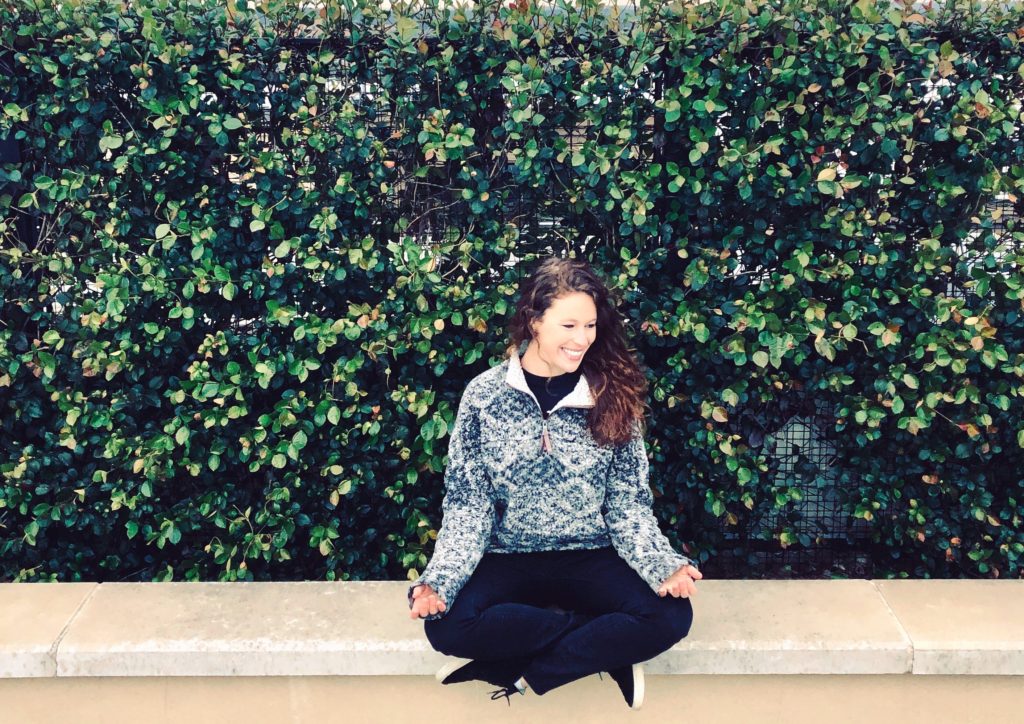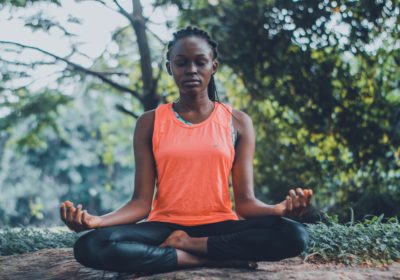
I always thought new years’ resolutions were bullshit until the one that changed my life.
Just a year ago, sitting with a furrowed brow, I contemplated what the coming year would bring and vowed to commit myself to a daily mindfulness meditation practice.
One decision and the dedication that would follow changed my view on the world and my experience within it.
Anxiety affects millions of people every day, over 40 million in the US alone. (1) I am no stranger to the feeling – panic, hyperventilation, racing thoughts, muscle tension, fatigue, worry, emotional dysregulation, defiance, and fear.
Mindfulness meditation did not eliminate these feelings, but it did something far more impactful.
Mindfulness taught me how to feel anxiety and not be consumed with it. The lessons taught in daily practice overflowed into everyday life.
Today I’m going to share with you the real-life benefits of mindfulness and simple steps to build a daily practice.
Real-Life Benefits of Mindfulness
Anxiety is a fear-fueled emotion that evolved to protect us from threats. When it becomes maladaptive, life starts to look like a threat. Even my own thoughts became threatening.
The siren of anxiety became too loud to bear, trapping me within my mind. Focusing, planning, overthinking, and worrying about thoughts and other false threats while the outside world passed by in a haze.
Mindfulness broke the spell.
Waking up to the Present
Ten days of daily meditation had passed, and something amazing happened. Experts call it an awakening, but to me, it felt like a miracle.
I had stepped into the real word for the first time in 26 years. My anxiety was present, but I was somehow floating above the water instead of drowning within it.
Being uncomfortable was less painful, learn more about using mindfulness and exposure to work through anxiety here.
As I think back, words elude me. I felt connected to others, a feeling of profound peace and understanding within. For the first time, I didn’t feel confused or broken. I felt whole and separate from the thoughts and feelings that once defined me.
Two days I spent in this glorious state – fully alive in the here and now. The days to follow would bring immense sadness as I fell back into a less awake state but also a profound understanding of how life could be.
The fire was lit, and there was no going back. Mindfulness meditation had opened the door to my true self and ability to feel fully alive behind the veil of anxiety. There was no turning back now.
Building a Positive Relationship with Thoughts and Feelings
When we begin to sit quietly with our minds, we begin to notice how loud the voice of our mind is.
Sam Harris, neurobiologist and meditation leader, refers to this voice as “an unwelcome house guest that follows you around and refuses to stop talking.” An analogy that made me giggle from its truthfulness.
This unwelcome house guest can be even more enerving when it is perceiving everything as a threat and yelling irrational fears at the top of its lungs. Grabbing our attention and holding on like a pit bull in fear for its life.
One of anxiety’s unique talents is getting our mind to produce an internal dialogue around worrisome or answerless concerns.
Before mindfulness meditation, I identified with my thoughts and feelings. I believed I was in complete control over what I thought, and when “intrusive thoughts” arose, it meant there was something seriously wrong with me.
Sally Winston and Martin Seif, PsyD and PhD, break this illusion in their book “How to Overcome Unwanted Intrusive Thoughts.” They explain that thoughts are mostly out of our control and learning not to engage with them can make all the difference.
This scientific approach of not identifying with thoughts and feelings is also a mindfulness technique.
This mindfulness technique can be practiced through meditation and later used in everyday life. By seeing thoughts and feelings as separate from myself, I began to release the guilt and shame of things I could not control.
The internal dialogue, which was the most frustrating part of anxiety, began to quiet down. Thoughts are allowed to arise and be released without an argument about their intention.
Releasing Judgement and Viewing Life Objectively
Mindfulness involves non-judgemental awareness while allowing things to be as they are.
Jon Kabat Zinn, PhD and mindfulness meditation master, explains mindfulness as a practice that focuses on arriving where we are. As he puts it in the title of his book, “Wherever you go, there you are.”
The mind is tricky, and to truly observe it, we need to do so without judgment.
Jack Kornfield, American author and vipassana teacher, tells a helpful anecdote for nonjudgemental awareness.
A researcher gathered never before seen behaviors of gorillas. When other scientists ask how he was able to collect so much information, the gorilla researcher replied, “Well, I did not bring a gun as I observed the gorillas.”
Judgment is like a gun. It is threatening and, when present, hides the true nature of our mind.
Mindfulness teaches us how to be aware of what is without trying to change it or wish it was something else.
With mindful awareness, there is room for all unpleasant and pleasant sensations. Neither experience is more essential or welcome than another.
An objective point of view allows us to really begin to understand the aspects of life that affect our thoughts, feelings, and behavior. Adding small mindful moments throughout the day can help expand this type of objective awareness.
How to Start a Daily Meditation Practice
Ten to twenty minutes a day is all that is needed to start a daily meditation practice. Mindfulness is simple and straight forward, but my-oh-my have I witnessed some severe resistance.
Mental exercise is about as appealing as physical exercise. Meditation can make us uncomfortable and require us to confront the thoughts and feelings we have been running from.
Through dedicated practice, I learned a few things that made an incredible impact on my ability to be consistent with a daily mindfulness meditation practice.
Some quick tips are:
- Meditate at the same time every day.
- Most experts suggest meditating in the morning but select a time that works best for you. Selecting a particular time helps you stay on track and leave out any guesswork of when to meditate, making consistency easier to maintain and missing sessions less likely.
- Select a primary location for meditating.
- Many meditation masters suggest finding a “meditation spot” and using it consistently to reinforce the discipline of a daily practice. If you are prone to traveling, like me, selecting a primary location may be more difficult. Pick the central spot at home and alternative places when traveling.
- Start with a guided meditation app for support.
- Learning how to meditate can be hard, especially without a guide. Having guided support not only teaches you how to meditate but tracks your daily progress. The Waking Up app is, by far, my favorite. It is a fantastic support system that taught me, step by step, how to do mindfulness meditation.
- Journal your meditation experiences.
- Right after you meditate, turn to a journal and write down your experience. It can be as little as five minutes. Journaling will help you make sense of your experiences, find patterns within them, and realize the value of meditating more quickly.
- Share your meditation priority with others.
- Making meditating a priority and sharing it with others helps you stay on track even when life happens. Traveling, plans, and unforeseen events can disrupt any routine. Letting others know the benefits and your dedication to practice can help them support you when you need to step away for a few minutes to meditate.
- Three minutes is better than no minutes.
- Life is busy, and excuses are one in a million. When your brain starts to throw up excuse number ten, remind yourself that three minutes is all you need. Taking a few moments to meditate makes a big difference, remind yourself of this even when you want to deem yourself too busy to practice.
- Don’t punish yourself if you miss a day.
- Days will get missed, and when they do, try not to shame yourself for it. When the sun rises, begin again. Learning to begin again is one of the most important lessons of meditation, and this is a great time to practice it.
If you want to learn more in-depth information about starting a daily meditation practice, this article is a great place to start.
If you are looking for some mindfulness activities to integrate into daily life separate from a formal practice, check out this article.




You could definitely see your enthusiasm in the work you write.
The arena hopes for even more passionate writers like
you who aren’t afraid to say how they believe.
At all times follow your heart.
Thank you so much, Cristina!
Such a nice calm relaxing blog
Thank you, Tommy!